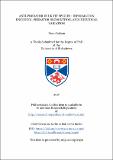Files in this item
Anti-predator behaviour in UK tit species : information encoding, predator recognition, and individual variation
Item metadata
| dc.contributor.advisor | Healy, Sue | |
| dc.contributor.advisor | Templeton, Christopher N. | |
| dc.contributor.author | Carlson, Nora | |
| dc.coverage.spatial | [10], 192 p. | en_US |
| dc.date.accessioned | 2017-08-03T14:15:47Z | |
| dc.date.available | 2017-08-03T14:15:47Z | |
| dc.date.issued | 2017-06-21 | |
| dc.identifier.uri | https://hdl.handle.net/10023/11366 | |
| dc.description.abstract | To combat the ever-present threat of predation many species produce anti-predator vocalizations and behaviours (mobbing) designed to drive predators away. These vocalizations can encode a predator’s threat level, and many species within a community will eavesdrop on this information. To determine how prey species produce, use, and respond to anti-predator information and how individual, social, and phylogenetic factors of different species may influence this behaviour, I conducted a series of robotic-predator presentation and anti-predator vocalization playback experiments in the wild and lab. I predicted that UK Paridae would encode information the same as previously studied species. I found that UK Paridae encode predator information in different ways, and that neither phylogeny nor ecology explained the patterns of similarity in how different species encode predator threat in their calls. Flock structure appeared to affect how species encoded predator threat and while multiple species may be sources of information for familiar flock mates, only blue and great tits met the criteria to be community informants. As blue and great tits need prior experience to recognize novel predators and juvenile great tits avoid novel predators only after seeing adults mob them, tits may use mobbing calls to learn about novel predators. While they responded to mobbing calls, juvenile blue and great tits did not engage in mobbing behaviour although they appear capable of doing so. Furthermore, while individuals varied in their responses to aerial alarm calls this variation was not explained by either their proximity to the call nor their personality. In this close examination of how anti-predator vocalizations are produced and used by UK Paridae, I found variation in these signals. This challenges previous assumptions about how Paridae encode information, raising questions as to the sources of this variation. | en_US |
| dc.language.iso | en | en_US |
| dc.publisher | University of St Andrews | |
| dc.subject | Mobbing | en |
| dc.subject | Predator-prey dynamics | en |
| dc.subject | Acoustic communication | en |
| dc.subject | Antipredator behaviour | en |
| dc.subject | Information encoding | en |
| dc.subject | Paridae | en |
| dc.subject | Predator recognition | en |
| dc.subject | Aerial alarm calls | en |
| dc.subject | Learning | en |
| dc.subject.lcc | QL696.P2615C2 | |
| dc.subject.lcsh | Predation (Biology) | |
| dc.subject.lcsh | Titmice--Behaviour | |
| dc.title | Anti-predator behaviour in UK tit species : information encoding, predator recognition, and individual variation | en_US |
| dc.type | Thesis | en_US |
| dc.contributor.sponsor | University of St Andrews. 600th Anniversary Scholarship | en |
| dc.contributor.sponsor | University of St Andrews. St Leonard's College Scholarship | en |
| dc.type.qualificationlevel | Doctoral | en_US |
| dc.type.qualificationname | PhD Doctor of Philosophy | en_US |
| dc.publisher.institution | The University of St Andrews | en_US |
| dc.identifier.doi | https://doi.org/10.17630/10023-11366 |
This item appears in the following Collection(s)
Items in the St Andrews Research Repository are protected by copyright, with all rights reserved, unless otherwise indicated.

